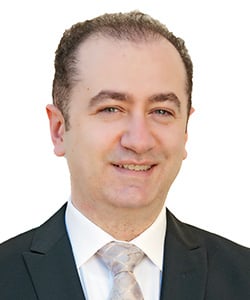Optimizing PRP Therapy: Can Platelet-Rich Plasma Characteristics Predict Treatment Outcomes for Knee Osteoarthritis?
Cite as: Kanuri SH, Maoli F, Eshraghi Y, Buchheit T. Optimizing PRP therapy: can platelet-rich plasma characteristics predict treatment outcomes for knee osteoarthritis. ASRA Pain Medicine News 2025;50. https://doi.org/10.52211/asra020125.009.
Osteoarthritis (OA) is a prevalent and debilitating degenerative joint disease that affects over 30 million Americans.1 Traditional pharmacologic treatments, such as NSAIDs and corticosteroids, can provide symptom improvement but often have side effects.2 Hyaluronic acid injections may provide longer-term pain relief for some patients, but the analgesic and functional gains are often limited.3 Geniculate radiofrequency ablation may be an option for patients with more advanced OA. Still, it is considered experimental by some insurance carriers despite evidence demonstrating improved function and quality of life. This limitation reduces its accessibility. These treatment gaps have prompted the search for more enduring interventions.
In recent years, biologically based therapies such as platelet-rich plasma (PRP) have gained increasing traction for the treatment of musculoskeletal conditions, including OA. Although PRP has been promoted as an effective therapy for mild to moderate knee OA,4 several large, negative clinical trials refute that claim.5,6 Understanding these contradictory research findings in the treatment of OA is difficult, given the numerous devices currently available to create PRP, each with widely varying output characteristics.7 Although several ASRA Pain Medicine Regenerative Medicine SIG members have written about the importance of publishing product characteristics for PRP,8 a standard classification and reporting system has yet to be widely adopted.9 The term “PRP” describes a range of products from 8-10 times baseline platelet concentrations to those with platelet counts in the physiologic range.10 Likewise, PRP may contain high concentrations of leukocytes or be nearly depleted of these immune cells. These inconsistencies make it difficult for the practitioners to decide on optimal PRP processing methods for the patient and the condition treated.11
To gain better insight into the characteristics of PRP products and factors contributing to treatment success, we selected eight representative publications of PRP for OA (four positive trials and four negative trials). We only selected publications that were prospective, randomized, blinded trials with a single intervention control arm. We excluded combination interventions (eg, PRP with hyaluronic acid, comparative effectiveness trials, and other trial designs) from the review. After extensive discussions, the authors also included a PRP trial for treating ankle OA.6 The high-profile nature of the study, the authors’ conclusions that PRP is ineffective for OA, and the lack of scrutiny regarding platelet counts in subsequent letters to the editor of JAMA12 necessitated the inclusion of this publication in our discussion. We reviewed the platelet concentrations, leukocyte counts, and number of injections in the trials and noted characteristics associated with PRP intervention's success (or failure) (Tables 1 and 2).
| Author | Study Design | Diagnosis | Change in Platelet Concentration from Baseline | Leukocytes | Control | Number of PRP Injections | Number of Patients | Primary Outcome |
| Chu et al. 13 | Prospective randomized, double-blind, multicenter clinical trial | Knee OA | 4.3X | Leukocyte poor PRP | Saline | 3 weekly intra-articular (IA) injections | 610 | Significantly greater improvement in WOMAC pain and function scores at 6,12, 24, and 60 months in the PRP group compared with saline. Greater preservation of cartilage volume in the PRP group at 60 months. |
| Patel et al14 | Prospective randomized, double-blind trial | Knee OA | 3X | Leukocyte poor PRP | Saline | Group A: 1 IA. Group B: 2 IA, 3 weeks apart. Group C: Saline | 78 | Significantly greater improvement in WOMAC scores in PRP groups at 6 months when compared with saline |
| Bansal et al15 | Prospective randomized double-blind trial | Knee OA | 7.6X | Leukocyte poor PRP | HA | 1 IA | 150 | Compared with HA, there were significantly greater improvements in WOMAC and IKDC in the PRP group at 6 and 12 months. |
| Park et al16 | Prospective randomized double-blind trial | Knee OA | 3X | Leukocyte rich PRP | HA | 1 IA | 110 | Compared with HA, there was significantly greater improvement in the IKDC scores at 6 months in the PRP group. |
| Author | Study design | Diagnosis | Change in Platelet Concentration from Baseline | Leukocytes | Control | Number of PRP Injections | Number of Patients | Primary Outcome |
| Paget et al6 | Prospective, double-blind, randomized, multicenter clinical trial | Ankle OA | Not Reported. Other studies report 1.4-1.7X for PRP devices used17,19 | Leukocyte poor PRP | Saline | 2 IA, 6 weeks apart | 100 | There was no significant difference in AOFAS scores (pain and function) between PRP and saline at 6 months. |
| Bennell et al5 | Prospective triple-blinded randomized clinical trial | Knee OA | 1.2X** | Leukocyte poor PRP | Saline | 3 weekly IA | 288 | There was no significant difference in pain scores or cartilage volume at 12 months between the PRP and saline groups. |
| Lewis et al18 | Prospective triple-blinded randomized clinical trial | Knee OA | Not Reported. Other studies report 1.4-1.7X for PRP devices used17,19 | Leukocyte poor PRP | Saline | Group A: 1 IA + 2 saline IAs, weekly Group B: 3 IAs, weekly | 102 | There was no significant difference in pain or function scores at 12 months between the PRP and saline groups. Additional PRP injections did not change the outcome. |
| Cole et al19 | Prospective, randomized, double-blind controlled trial | Knee OA | 1.7X | Leukocyte poor PRP | HA | 3 weekly IA | 111 | There was no significant difference in WOMAC pain scores at 3,6 and 12 months between PRP and HA groups. |
** Change in platelet concentration calculated from Bennell et al. published supplemental data.
Discussion
Over the past decade, our understanding of OA has evolved as a complex immunologic disorder characterized by alterations in cytokine and growth factor expression.20 PRP, an autologous blood product enriched with these bioactive components, has emerged as a potential treatment to promote cartilage health and produce analgesia.21 However, PRP and related biologic therapies are not panaceas. These products need to be scrutinized for optimal outcomes. Standard preparation protocols should be established along with internationally accepted criteria for what defines PRP.
In our four representative positive clinical trials of PRP, all contained platelet concentrations of 3X or greater when compared with patients’ baseline.13-16 The four negative studies we reviewed share a common characteristic of having lower platelet concentrations (between approximately 1.2-1.7X of baseline).5,6,18,19 These clinical outcomes are consistent with laboratory research demonstrating the need for robust concentrations of growth factors to promote healing, tissue repair, and the resolution of pain.22,23 Studies have indicated that optimal tissue regeneration responses are likely achieved when platelet concentrations range from 1 to 1.5 × 10^6 platelets/microliter,24,25 well above the 1.2-1.7X concentrations noted in these four negative trials.
Another factor that we reviewed in the eight studies was leukocyte concentration. PRP is generally categorized as leukocyte-rich (white blood cell count above baseline) or leukocyte-poor (below baseline). The impact of leukocytes on PRP has been controversial. Pre-clinical and clinical research shows that higher leukocyte concentrations can promote acute inflammation and elevations of catabolic cytokines such as IL-1 and TNF-α.26 These concerns over inflammatory response have prompted some recommendations for leukocyte-poor PRP (LP-PRP) to treat knee osteoarthritis, thereby minimizing pain and inflammation from the procedure.27
Studies that use PRP with at least 3X concentration appear to be more successful in producing analgesia for patients with osteoarthritis.
Those recommendations for LP-PRP products, however, have not gone without criticism. Leukocytes are also known to stimulate cell proliferation and tissue repair.28 Research by Ehrenfest et al. demonstrated that neutrophils stimulate platelets to release growth factors. They saw enhanced chondrocyte proliferation in animal models of OA treated with PRP enriched with leukocytes.29,30 The importance of leukocytes in PRP, therefore, remains debated. In the four negative PRP studies, all were leukocyte-reduced products. In the four positive PRP studies, leukocyte concentrations were variable. It remains challenging to draw conclusions from these data other than to note that leukocyte concentrations in PRP do not appear as critical for success as platelet enrichment.
The optimal number of PRP intra-articular (IA) injections remains unclear from our sample publications. In three studies14–16, a single PRP IA injection was administered, and four studies 5,13,18,19 provided three weekly IA injections. In one study,14 injections were given every three weeks; in another study,6 the injections were spaced six weeks apart. Several negative studies used multiple injections, and two positive studies used only one. These data lead us to surmise that the characteristics of the injected PRP are likely more important than the number of injections for achieving successful outcomes.
More detailed reporting on PRP characteristics in these and similar clinical studies needs to be done. Minimal Information for Studies Evaluating Biologics in Orthopedics guidelines have been proposed, including study design, intervention, blood characteristics, PRP characteristics, processing, and outcomes. In a recent meta-analysis of PRP studies, it was noted that almost 50% of studies do not adhere to these guidelines.31 Inadequate reporting leads to difficulty in interpreting (and reproducing) research. These limitations were highlighted in a systematic review by Chahla et al., which found that out of 105 studies using PRP in orthopedics, only 11 provided comprehensive reporting of the PRP preparation protocol usable by subsequent researchers. Further, only 17 studies offered qualitative metrics on the composition of their PRP.32 Product information is needed to effectively compare, replicate, and validate findings.
Conclusion
Our review of eight studies of PRP for OA, including calculations of platelet concentrations from primary and supplemental data sources, highlights a clear relationship between platelet concentration and clinical trial success. The four positive trials reported platelet counts of 3X or greater over baseline. The negative trials showed lower platelet concentrations ranging from 1.2-1.7X above baseline. Although this analysis is not a systematic review of the literature, the observed trend of these eight studies suggests a potential threshold for therapeutic efficacy. The impact of leukocyte concentration and the number of injections appear less consistently associated with successful outcomes. We look forward to future research to better define the optimal PRP characteristics for OA and other degenerative conditions, which could pave the way for more disease-specific, standardized treatment protocols.




References
- Zhang Y, Jordan JM. Epidemiology of osteoarthritis. Clin Geriatr Med 2010;26(3):355-69. https://doi.org/10.1016/J.CGER.2010.03.001
- McAlindon TE, Bannuru RR, Sullivan MC, et al. OARSI guidelines for the non-surgical management of knee osteoarthritis. Osteoarthritis Cartilage 2014;22(3):363-88. https://doi.org/10.1016/J.JOCA.2014.01.003
- Hunt C, Provenzano DA, Eshraghi Y, et al. Should intra-articular hyaluronic acid be used routinely for knee osteoarthritis pain? PM R 2022;14(7):879-85. https://doi.org/10.1002/PMRJ.12740
- Filardo G, Previtali D, Napoli F, et al. PRP injections for the treatment of knee osteoarthritis: a meta-analysis of randomized controlled trials. Cartilage 2021;13(1_suppl):364S-75S. https://doi.org/10.1177/1947603520931170
- Bennell KL, Paterson KL, Metcalf BR, et al. Effect of intra-articular platelet-rich plasma vs placebo injection on pain and medial tibial cartilage volume in patients with knee osteoarthritis: the RESTORE randomized clinical trial. JAMA2021;326(20):2021-30. https://doi.org/10.1001/JAMA.2021.19415
- Paget LDA, Reurink G, De Vos RJ, et al. Effect of platelet-rich plasma injections vs placebo on ankle symptoms and function in patients with ankle osteoarthritis: a randomized clinical trial. JAMA 2021;326(16):1595. https://doi.org/10.1001/JAMA.2021.16602
- Magalon J, Bausset O, Serratrice N, et al. Characterization and comparison of 5 platelet-rich plasma preparations in a single-donor model. Arthroscopy 2014;30(5):629-38. https://doi.org/10.1016/J.ARTHRO.2014.02.020
- Buchheit T, Hunt C, Eldrige J, et al. Product characteristics should be reported in all biological therapy publications. Reg Anesth Pain Med 2022;47(7):449. https://doi.org/10.1136/RAPM-2022-103557
- Collins T, Alexander D, Barkatali B. Platelet-rich plasma: a narrative review. EFORT Open Rev 2021;6(4):225-35. https://doi.org/10.1302/2058-5241.6.200017
- Anastassakis K. Platelet-rich plasma (PRP). In: Androgenetic Alopecia From A to Z. Cham, Switzerland: Springer; 2023. https://doi.org/10.1007/978-3-031-10613-2_41
- Szwedowski D, Szczepanek J, Paczesny Ł, et al. The effect of platelet-rich plasma on the intra-articular microenvironment in knee osteoarthritis. Int J Mol Sci 2021;22(11). https://doi.org/10.3390/IJMS22115492
- Chu PJ. Platelet-rich plasma injections vs placebo for patients with ankle osteoarthritis. JAMA. 2022;327(8):779. https://doi.org/10.1001/JAMA.2021.24745
- Chu J, Duan W, Yu Z, et al. Intra-articular injections of platelet-rich plasma decrease pain and improve functional outcomes than sham saline in patients with knee osteoarthritis. Knee Surg Sports Traumatol Arthrosc2022;30(12):4063-71. https://doi.org/10.1007/S00167-022-06887-7
- Patel S, Dhillon MS, Aggarwal S, et al. Treatment with platelet-rich plasma is more effective than placebo for knee osteoarthritis: a prospective, double-blind, randomized trial. Am J Sports Med 2013;41(2):356-64. https://doi.org/10.1177/0363546512471299
- Bansal H, Leon J, Pont JL, et al. Platelet-rich plasma (PRP) in osteoarthritis (OA) knee: correct dose critical for long-term clinical efficacy. Sci Rep 2021;11(1). https://doi.org/10.1038/S41598-021-83025-2
- Park YB, Kim JH, Ha CW, et al. Clinical efficacy of platelet-rich plasma injection and its association with growth factors in the treatment of mild to moderate knee osteoarthritis: a randomized double-blind controlled clinical trial as compared with hyaluronic acid. Am J Sports Med 2021;49(2):487-96. https://doi.org/10.1177/0363546520986867
- Magalon J, Bausset O, Serratrice N, et al. Characterization and comparison of 5 platelet-rich plasma preparations in a single-donor model. Arthroscopy 2014;30(5):629-38. https://doi.org/10.1016/J.ARTHRO.2014.02.020
- Lewis E, Merghani K, Robertson I, et al. The effectiveness of leucocyte-poor platelet-rich plasma injections on symptomatic early osteoarthritis of the knee: the PEAK randomized controlled trial. Bone Joint J 2022;104-B(6):663-71. https://doi.org/10.1302/0301-620X.104B6.BJJ-2021-1109.R2
- Cole BJ, Karas V, Hussey K, et al. Hyaluronic acid versus platelet-rich plasma: a prospective, double-blind randomized controlled trial comparing clinical outcomes and effects on intra-articular biology for the treatment of knee osteoarthritis. Am J Sports Med 2017;45(2):339-46. https://doi.org/10.1177/0363546516665809
- Buchheit T, Huh Y, Maixner W, et al. Neuroimmune modulation of pain and regenerative pain medicine. J Clin Invest2020;130(5):2164. https://doi.org/10.1172/JCI134439
- Sakata R, Iwakura T, Reddi AH. Regeneration of articular cartilage surface: morphogens, cells, and extracellular matrix scaffolds. Tissue Eng Part B Rev 2015;21(5):461-73. https://doi.org/10.1089/TEN.TEB.2014.0661
- Berrigan WA, Bailowitz Z, Park A, et al. A greater platelet dose may yield better clinical outcomes for platelet-rich plasma in the treatment of knee osteoarthritis: a systematic review. Arthroscopy 2024;S0749-8063(24)00206-8). https://doi.org/10.1016/j.arthro.2024.03.018
- Straum OK. The optimal platelet concentration in platelet-rich plasma for proliferation of human cells in vitro-diversity, biases, and possible basic experimental principles for further research in the field: a review. PeerJ 2020;8:e10303. https://doi.org/10.7717/PEERJ.10303/SUPP-2
- Foster TE, Puskas BL, Mandelbaum BR, et al. Platelet-rich plasma: from basic science to clinical applications. Am J Sports Med 2009;37(11):2259-72. https://doi.org/10.1177/0363546509349921
- Gentile P, Garcovich S. Systematic review—the potential implications of different platelet-rich plasma (PRP) concentrations in regenerative medicine for tissue repair. Int J Mol Sci 2020;21(16):5702. https://doi.org/10.3390/IJMS21165702
- Hudgens JL, Sugg KB, Grekin JA, et al. Platelet-rich plasma activates proinflammatory signaling pathways and induces oxidative stress in tendon fibroblasts. Am J Sports Med 2016;44(8):1931-40. https://doi.org/10.1177/0363546516637176
- Braun HJ, Kim HJ, Chu CR, et al. The effect of platelet-rich plasma formulations and blood products on human synoviocytes: implications for intra-articular injury and therapy. Am J Sports Med 2014;42(5):1204-10. https://doi.org/10.1177/0363546514525593
- Headland SE, Jones HR, Norling L V., et al. Neutrophil-derived microvesicles enter cartilage and protect the joint in inflammatory arthritis. Sci Transl Med 2015;7(315):315ra190. https://doi.org/10.1126/SCITRANSLMED.AAC5608
- Dohan Ehrenfest DM, Rasmusson L, Albrektsson T. Classification of platelet concentrates: from pure platelet-rich plasma (P-PRP) to leucocyte- and platelet-rich fibrin (L-PRF). Trends Biotechnol 2009;27(3):158-67. https://doi.org/10.1016/J.TIBTECH.2008.11.009
- Xu Z, Yin W, Zhang Y, et al. Comparative evaluation of leukocyte- and platelet-rich plasma and pure platelet-rich plasma for cartilage regeneration. Sci Rep 2017;7. https://doi.org/10.1038/SREP43301
- Stone A V., Abed V, Owens M, et al. Randomized controlled trials on platelet-rich plasma for knee osteoarthritis poorly adhere to the minimum information for studies evaluating biologics in orthopaedics (MIBO) guidelines: a systematic review. Am J Sports Med 2024;52(6):1617-23. https://doi.org/10.1177/03635465231185289
- Chahla J, Cinque ME, Piuzzi NS, et al. A call for standardization in platelet-rich plasma preparation protocols and composition reporting: a systematic review of the clinical orthopaedic literature. J Bone Joint Surg Am2017;99(20):1769-79. https://doi.org/10.2106/JBJS.16.01374